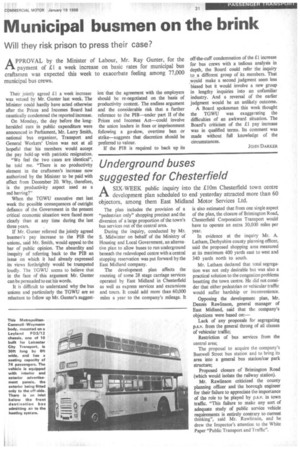Underground buses suggested for Chesterfield
Page 33

If you've noticed an error in this article please click here to report it so we can fix it.
1-1 A SIX-WEEK public inquiry into the £10m Chesterfield town centre development plan scheduled to end yesterday attracted more than 60 objectors, among them East Midland Motor Services Ltd.
The plan includes the provision of a "pedestrian only" shopping precinct and the diversion of a large proportion of the town's bus services out of the central area.
During the inquiry, conducted by Mr. S. Midwinter on behalf of the Ministry of Housing and Local Government, an alternative plan to allow buses to run underground beneath the redeveloped centre with a central stopping reservation was put forward by the East Midland company.
The development plan affects the routeing of some 28 stage carriage services operated by East Midland in Chesterfield as well as express services and excursions and tours. It could add more than 60,000 miles a year to the company's mileage. It is also estimated that from one single aspect of the plan, the closure of Brimington Road, Chesterfield Corporation Transport would have to operate an extra 30,000 miles per year.
In evidence at the inquiry Mr. A. Latham, Derbyshire county planning officer, said the proposed shopping area measured at its maximum 400 yards east to west and 340 yards north to south.
Mr. Latham declared that total segregation was not only desirable but was also a practical solution to the congestion problems
besetting the town centre. He did not consider that either pedestrian or vehicular traffic would suffer hardship or inconvenience.
Opposing the development plan, Mr. Dennis Rawlinson, general manager of East Midland, said that the company's objections were based on:— Lack of any proposals for segregating p.s.v. from the general throng of all classes of vehicular traffic; Restriction of bus services from the central area; The proposal to acquire the company's Beetwell Street bus station and to bring its area into a general bus stationkar park structure; Proposed closure of Brimimgton Road (which would isolate the railway station).
Mr. Rawlinson criticized the county planning officer and the borough engineer for their failure to appreciate the importance of the role to be played by p.s.v. in town traffic. "This failure to make any sort of adequate study of public service vehicle requirements is entirely contrary to current thinking", said Mr. Rawlinson, and he drew the Inspector's attention to the White Paper "Public Transport and Traffic".




















































































































